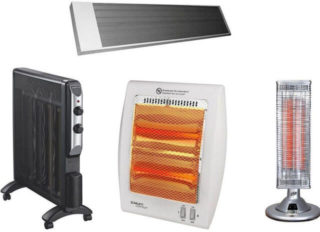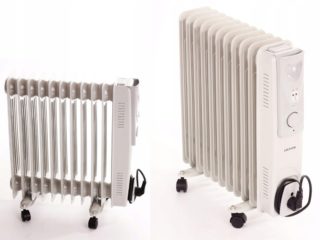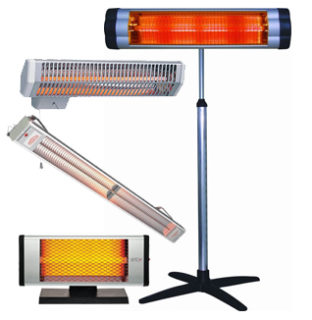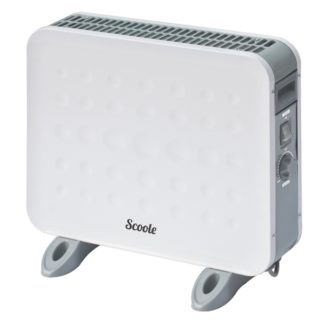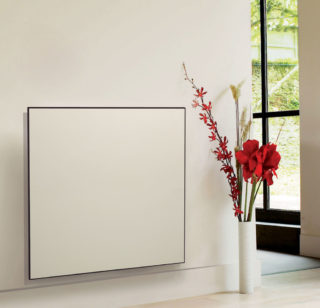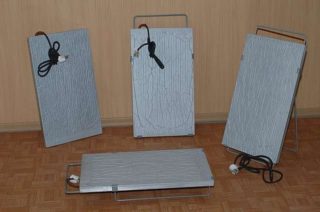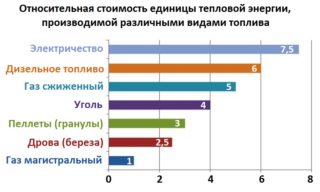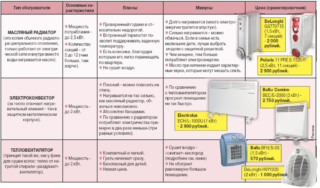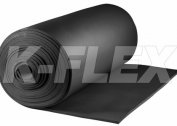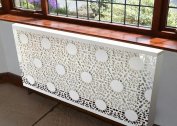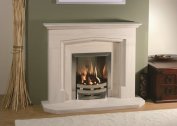In the off-season, the central heating system of apartments or the boiler room of a private house cannot produce full heating. An auxiliary equipment is used to ensure a normal temperature. A high-quality electric heater will help maintain a comfortable temperature until the start of heating.
Is it possible to heat the house with electricity?
For a private home, located away from the gas mains, electric heating will be a reasonable solution. Alternative heat sources have several advantages:
- lack of need for fuel combustion;
- reduction in stock replacement costs;
- no time is wasted laying fuel resources in the furnace;
- electricity is the finished fuel that the building is already equipped with.
Electric heating has several disadvantages. They consist in rising prices for utilities, shutdown in emergency mode and the cost of buying an autonomous generator.
Considering the fact that electric heating can be switched on at any time, it is expedient and economical to purchase a heater.
Types of Electric Heaters
The modern type of heating devices is economical and energy efficient. Manufacturers produce several modifications, so the owners of a private house can always choose the suitable option.
Oil heaters
Devices that are a case with technical oil inside must be selected for power. The heating process is responsible for the heater, which is in an oily environment.
The oil type of heaters has several positive qualities:
- the presence of a built-in thermostat that allows you to set the desired temperature;
- comfortable adjustment with one or two knobs;
- ease of transportation - a device the size of a standard radiator moves with the wheels;
- inexpensive price - no need to spend money to warm a cottage or a country cottage for the rest;
- good heat storage ability - the oil cools for a long time, therefore, after turning off the device from the network, residual heat can be used.
The oil options warm up for a long time, when you touch the red-hot case, your hand may burn. Due to the heavy weight, devices without wheels are not very mobile.
To reduce the warm-up time of the rooms, models that have a heat fan are used.
Infrared heating systems
The infrared type of heaters is equipped with lamps emitting waves at a frequency invisible to humans. The device operates on the principle of solar heat. Long infrared waves warm the walls, furniture, from which heat enters the air.
The benefits of operating devices include:
- minimum noise level in the operating mode;
- low power consumption;
- design without fans that do not emit dirt and dust;
- uniform and gradual heating of the installation zone;
- the possibility of operation in outdoor gazebos and on terraces;
- humidity does not change, since oxygen is not burned during heating.
Infrared devices can be mounted on a wall, table or floor.
Depending on the type of lamp, you can purchase an infrared device:
- halogen, inside of which there is a bulb made of glass with a special thread filled with an inert gas;
- quartz, where the coolant is tungsten wire;
- carbon fiber, heated by thin threads of carbon fibers.
The disadvantage of IR devices is the high price.
Convection models
This type of installation works on the principle of convection. Cold air is sucked in by the lower part of the heater, supplied through the heater. After heating, the air stream exits through the upper ventilation and enters the ceiling. Convection is a cyclic process in which the air masses are cooled and descend, re-entering the heater.
Convection electric heater has several advantages:
- does not make noise during work;
- the case heats up no more than 65 degrees;
- the built-in thermostat allows you to adjust the thermal regime, automatically start or stop the system;
- availability of emergency protection against overheating.
The disadvantages of convectors include problems with self-assembly and minimal heat transfer, in which it is difficult to warm up a large village house.
Ceramic heaters
Ceramic types of heaters are designed for an apartment or a house. The devices are a screen with heat reflection and the heater itself. They are designed as panels with an explosion-proof housing made of solid metal. The devices operate on the principle of convection or infrared radiation, they transfer heat to the air or to objects.
Depending on the installation method, you can find and install the following modifications:
- For wall mounting. The wall-mounted electric heater is similar to an air conditioner and is large in size. Thanks to the options of ionization, blade rotation speed or support of a certain temperature, it can be used as a split system.
- Floor standing. The ceramic apparatus is suitable for installation in any area of the room, warms up the air masses in any direction. The floor heater is equipped with a timer, built-in thermostat. It is relevant if you have a wooden house without central heating.
- Board. A small and compact device that is placed on a table, window sill or other object with protrusions.
- Ceiling. Form a warm airflow with a large dispersion radius. They can be used as the main heating of the building with electricity. The built-in temperature regulator provides a comfortable microclimate.
Ceiling ceramic models are only infrared type.
Quartz heating devices
A quartz heating source is a block where a heating element made of an alloy of chromium and nickel is located, it is infrared and monolithic. Quartz sand in the first case is used for a glass tube, in the second - as a material for casting panels. The heating apparatus is characterized by:
- uniform heating - heat is generated already 20 minutes after switching on;
- fully heated space of 10 m2 with a ceiling height of 10 m, because rated power is 0.5 kW;
- the parallel process of heating a nichrome spiral and air convection;
- the absence of a temperature regulator - the sand panel holds the temperature for a long time, but you need to turn it off yourself;
- high rate of efficiency - 99%;
- the ability to create a modular system of several installations.
A quartz apparatus is a good way for organizing auxiliary communications or independent operation.
Advantages and disadvantages of electric heating
Electric heating involves the production of heat by direct (transformation of electricity into heat) and indirect (using heat pumps) methods. By type of arrangement, the system can be local (energy converters are located in a room near the house) and central (remote electric boilers).
Electrical communications are a good option if you have a summer house, private or country house. They have several advantages:
- Ease of organization. You can create a system with skills and equipment yourself.
- No need to equip the boiler room and chimney.
- Safety for health and life, as carbon monoxide and combustion products are not emitted.
- Reliability and silent operation, as no fan and alluvial installations are used.
- No need for continuous monitoring of fuel and temperature sensors.
- High efficiency parameters. Electrical installations provide quick heating of individual rooms of private houses.
Electrical devices in the form of communications have several disadvantages:
- A large amount of energy consumed and a high fee for its use.
- The volatility of the structure.
- Risks of unstable voltage without an autonomous generator.
- Additional costs for the generator.
Heating with electricity is only possible with good wiring, a three-phase network and knowledge of the power consumption of the devices.
The specifics of energy-saving heaters
 An energy-saving heater with a power of up to 1000 W heats rooms with an area of 6-15 m2. Manufacturers produce energy-saving heaters for the home of the following modifications:
An energy-saving heater with a power of up to 1000 W heats rooms with an area of 6-15 m2. Manufacturers produce energy-saving heaters for the home of the following modifications:
- Tape and needle. They have a simple design and low cost. The disadvantage of the equipment is a large energy consumption, the absence of heat storage systems, the inability to install in wet rooms.
- With a protective cover. Thanks to the outer aluminum fins, the electric heater is protected from moisture. The casing is filled with materials with high thermal conductivity. Moisture-resistant housing makes it possible to install equipment in the bathroom or kitchen. The disadvantage of the devices is cracking of the case due to the different expansion coefficient of aluminum and steel.
- Monolithic heaters. Efficient in terms of heating and economical type of appliances. Inside the case with aluminum plates are dielectrics. Monolithic models are durable and silent, but expensive.
Compared to standard models, energy-saving electric radiators designed for the home save about 50% of energy.
Features of the use of electric heaters
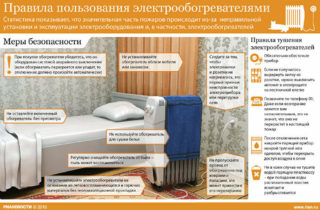 The proper operation of electric heaters for an apartment or a house requires compliance with a number of requirements:
The proper operation of electric heaters for an apartment or a house requires compliance with a number of requirements:
- The device only connects to a working outlet without auxiliary devices. Otherwise, the contacts may become hot, and the wiring may melt.
- The minimum distance of the device from other objects in the room is 50 cm.
- Installation of the heater is not carried out near the windows with curtains.
- Before leaving home, you need to set the automation unit.
- Towels and wet laundry must not be dried on a thermal heater.
- Connection is made only according to the manufacturer's instructions.
An additional line from the switchboard is laid for the electric heater.
Rules for choosing a device
Before purchasing an electric heater, you must pay attention to the following parameters:
- Type of apparatus and its capabilities. Convectors do not emit odors during operation; they are quiet and economical, but they dry the air. Oil devices are silent, but warm for a long time and require operating costs. Infrared models have two drawbacks - lack of inertia and high price.
- The area of heating. All heaters, with the exception of IR, should emit 100 watts per square with standard ceiling heights. For infrared models, the index of 100 W x 1 m2 is not the minimum, but the maximum.
- Dimensions Wide and low units are installed next to large windows and stained-glass windows. Tall and narrow devices are suitable for rooms with limited quadrature.
- Type of management.Mechanically controlled heaters are cheaper, but their functionality is minimal, and the temperature error reaches several degrees. Electronic control is accurate, but constant illumination irritates the eyes.
- Safety. Oil radiators without a thermostat heat up to 150 degrees, and when you touch them there are risks of burns. Ceramic and micathermic models are the safest ones, suitable for educational institutions and families with children.
- Heating rate. Fan heaters or oil heaters quickly warm the room. Models with thermostats keep the temperature constant, but they dry the air and make noise. Infrared ceramic devices heat the space pointwise.
For comfortable use, it is better to choose devices with a remote control.
A household electric heater is an alternative to gas heating. The device does not connect to the network all the time, which saves on electricity costs. When choosing it, you should pay attention to the type of coolant, the area of the room and mobility.
